Porcupine Grass Miscanthus sinensis 'Strictus' (v)
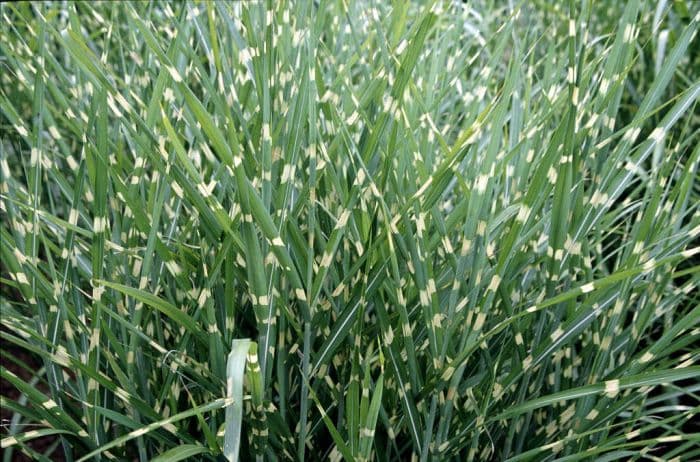
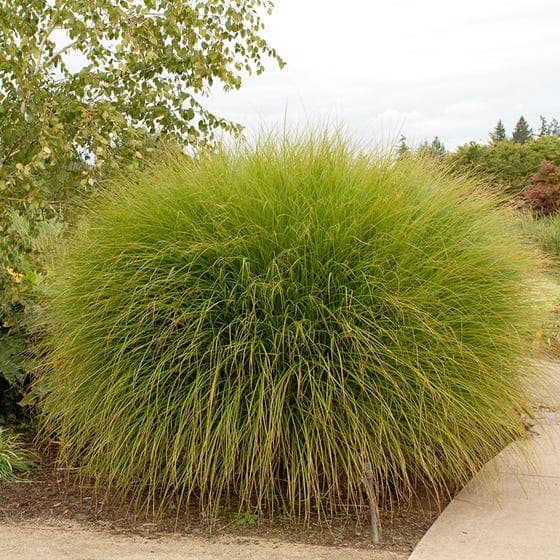
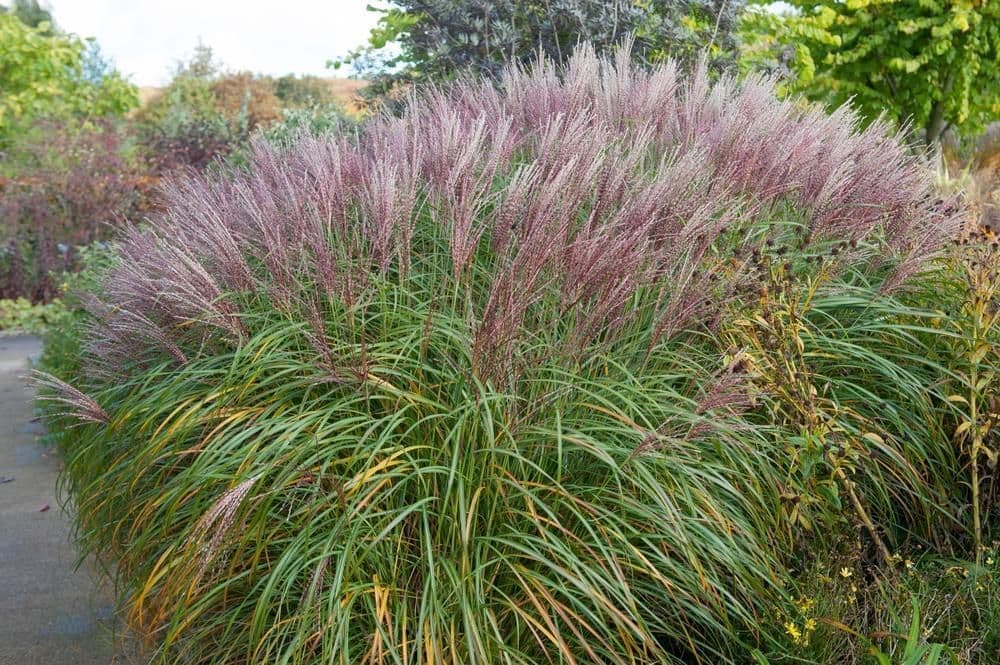
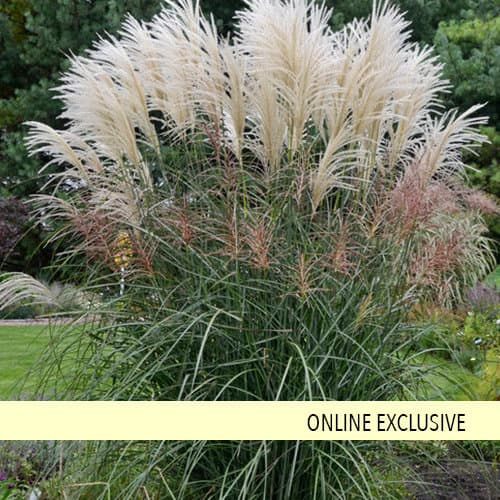

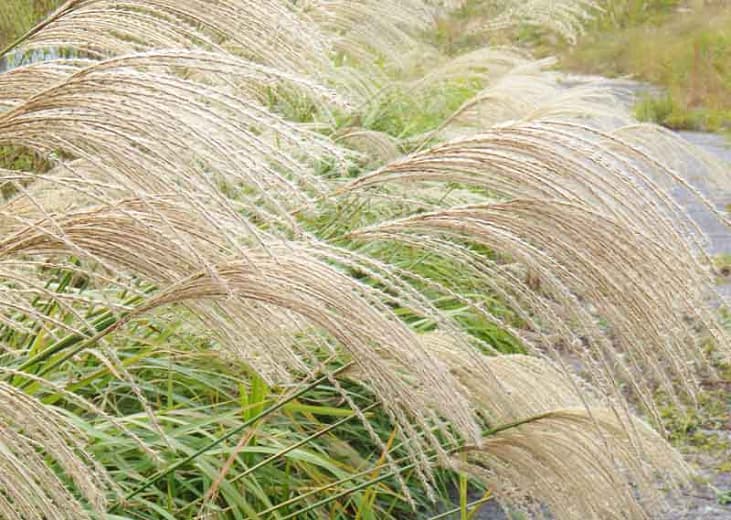

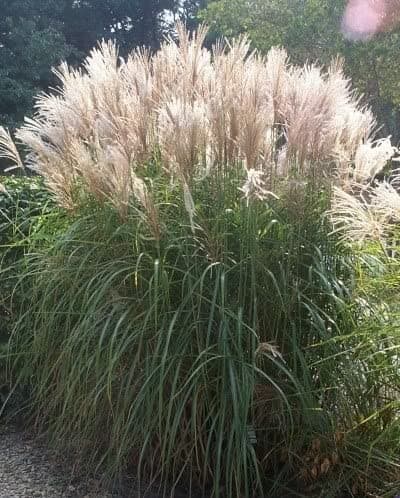
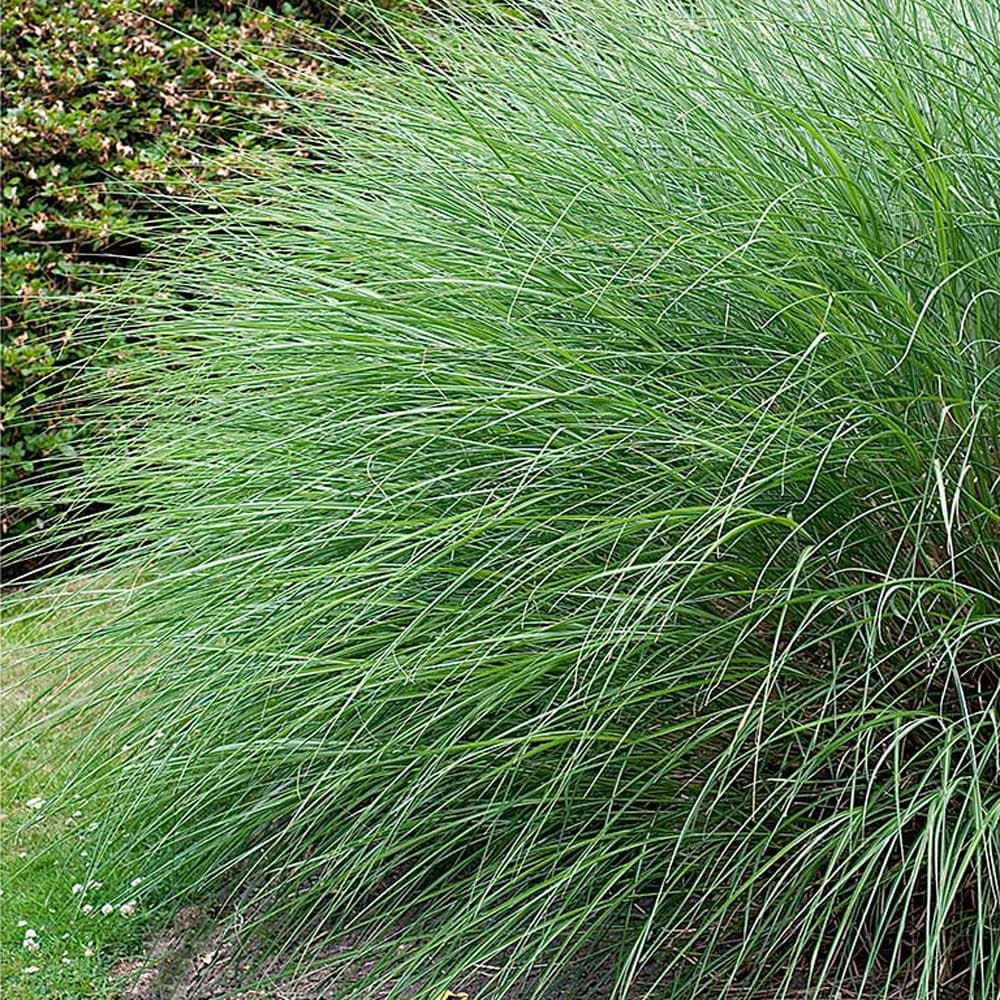
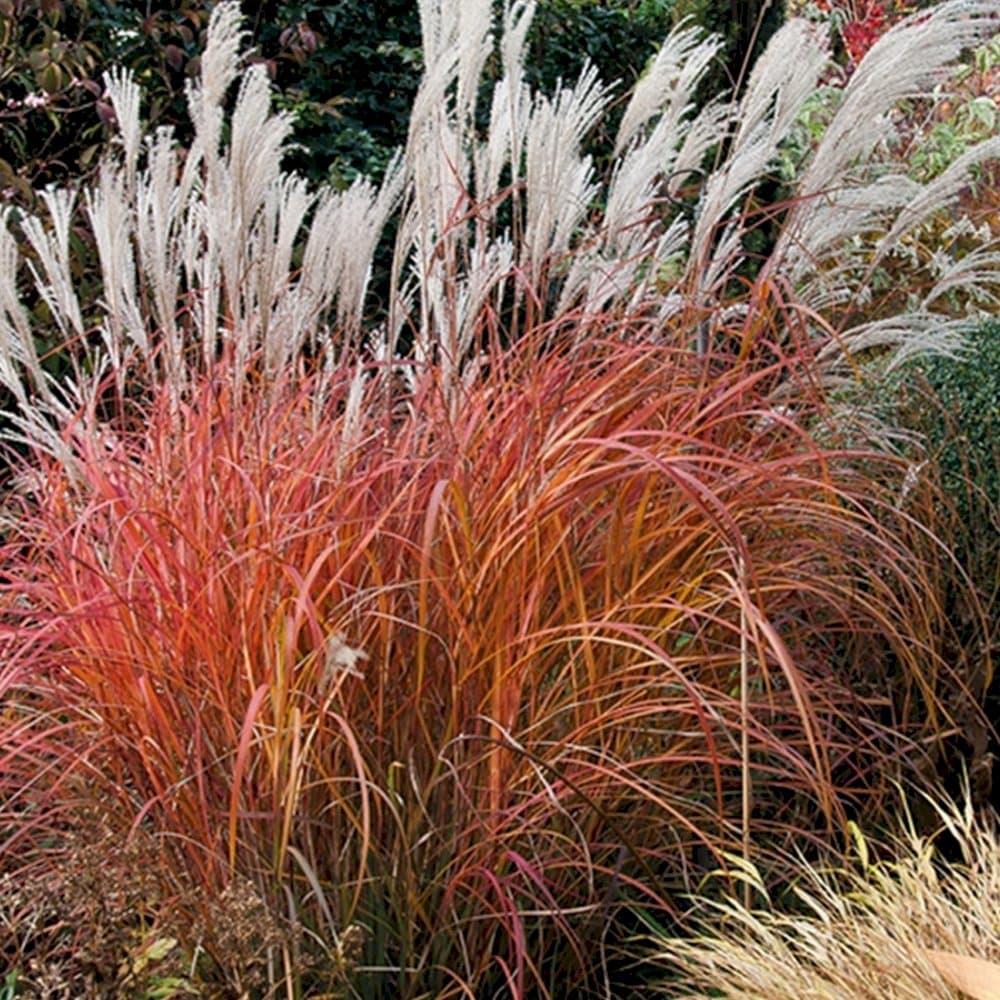

ABOUT
Miscanthus sinensis 'Strictus', commonly known as Porcupine Grass, is an ornamental grass renowned for its striking appearance. It features long, narrow leaves that have a distinctive horizontal banding pattern of creamy yellow to pale white, resembling the stripes on a porcupine's back; this gives the plant its common name. These banded leaves are quite stiff and arch outward, creating a fountain-like effect that adds texture and movement to the garden. The foliage is deep green in colour, contrasting beautifully with the creamy stripes, and the leaves take on hues of copper, orange, and gold in the fall, further enhancing the display. In late summer to fall, Porcupine Grass produces feathery plumes that are held above the foliage, starting out pinkish or reddish before maturing to a soft silvery grey. These plumes are often used in floral arrangements, both fresh and dried, for their enduring beauty. Overall, the plant has a clumping form and is appreciated for its year-round visual interest as well as its tolerance for a variety of growing conditions. It adds structure to gardens and landscapes, offering a vertical element without the need to specify its size.
About this plant
 Names
NamesFamily
Poaceae
Synonyms
Zebra Grass, Porcupine Grass, Japanese Silver Grass, Maiden Grass
Common names
Miscanthus sinensis var. condensatus 'Strictus', Miscanthus sinensis 'Zebrinus', Eulalia japonica var. strictus.
 Toxicity
ToxicityTo humans
Porcupine grass is not known to be toxic to humans. There are no common symptoms of poisoning because it is generally considered safe. However, as with many plants, individual allergies and sensitivities could potentially cause mild irritation if the plant material is handled or ingested, but such cases are rare.
To pets
Porcupine grass is not known to be toxic to pets. The plant does not typically cause symptoms of poisoning as it is not considered poisonous. However, ingestion of any plant material can sometimes result in gastrointestinal upset for pets due to the physical nature of the material, rather than chemical toxicity.
 Characteristics
CharacteristicsLife cycle
Perennials
Foliage type
Deciduous
Color of leaves
Variegated
Flower color
Silvery
Height
6 feet (1.8 meters)
Spread
4 feet (1.2 meters)
Plant type
Grass
Hardiness zones
4-9
Native area
Asia
Benefits
 General Benefits
General Benefits- Ornamental Value: Adds striking vertical interest to gardens with its tall, banded foliage.
- Drought Tolerance: Once established, it requires minimal watering, making it suitable for xeriscaping.
- Low Maintenance: Requires very little care once it is established, other than occasional cutting back.
- Erosion Control: Its robust root system helps to stabilize soil and prevent erosion.
- Winter Interest: Retains structure and offers visual interest in the garden during the dormant season.
- Wildlife Habitat: Provides shelter and nesting material for birds and other wildlife.
- Privacy Screen: Can be used to create a natural privacy barrier due to its dense growth habit.
- No Serious Pests or Diseases: Generally resistant to pests and diseases which minimizes the need for chemical treatments.
- Tolerance to Poor Soil: Adapts to a wide range of soils, including clay and sandy substrates.
 Medical Properties
Medical PropertiesThis plant is not used for medical purposes.
 Air-purifying Qualities
Air-purifying QualitiesThis plant is not specifically known for air purifying qualities.
 Other Uses
Other Uses- As a musical instrument material: The sturdy canes of Porcupine Grass can be used in the construction of wind instruments such as flutes or panpipes due to their hollow structure.
- In crafting and basketry: The flexible, yet strong stems can be woven into baskets or used in crafting for decorative purposes.
- For paper making: The fibrous content of Porcupine Grass can be processed to produce a type of hand-made paper.
- As livestock bedding: The dry leaves and stems can be used as a bedding material for livestock, providing comfort and insulation.
- For erosion control: Planted on slopes or riverbanks, Porcupine Grass can help to stabilize soil and prevent erosion due to its dense root system.
- As a biofuel source: Porcupine Grass can be harvested and converted into biofuel, offering an alternative energy source.
- In the fashion industry: Stems and fibers of Porcupine Grass could be incorporated into textiles and used to produce eco-friendly fabrics.
- As a sound barrier: Due to its height and density, Porcupine Grass can be used in landscapes to reduce noise pollution.
- In aquaculture: The roots of Porcupine Grass can purify water by absorbing excess nutrients and pollutants, making it suitable for use in aquaculture systems.
- As garden pathways: Dried stems can be laid down to create natural, rustic-looking pathways through gardens and outdoor spaces.
Interesting Facts
 Feng Shui
Feng ShuiThe Zebra Grass is not used in Feng Shui practice.
 Zodiac Sign Compitability
Zodiac Sign CompitabilityThe Zebra Grass is not used in astrology practice.
 Plant Symbolism
Plant Symbolism- Adaptability: Miscanthus sinensis 'Strictus', also known as Porcupine Grass, is known for its ability to thrive in a variety of soil conditions, symbolizing the ability to adapt to diverse environments and situations.
- Resilience: The hardiness of Porcupine Grass, allowing it to survive through different seasons, represents resilience and the capacity to endure challenges.
- Privacy: When used as a hedge or privacy screen, Porcupine Grass symbolizes the desire for solitude or personal space.
- Growth: The fast-growing nature of Porcupine Grass is often associated with personal or spiritual growth and the pursuit of continual improvement.
- Beauty: With its unique striped pattern and feathery plumes, Porcupine Grass signifies an appreciation for beauty and natural aesthetics.
- Flexibility: Despite its upright growth habit, Porcupine Grass is capable of bending and swaying with the wind, symbolizing flexibility and the ability to move with life’s changes without breaking.
 Water
WaterThe Zebra Grass should be watered regularly, especially within its first growing season to establish a deep, extensive root system. The soil should be kept evenly moist but not soggy. An average of about 1 inch of water weekly, either from rainfall or supplemental watering, is sufficient. During particularly hot or dry spells, you may need to water twice a week. Reduce watering in winter or during periods of heavy rainfall. It is important not to overwater, as this can lead to root rot.
 Light
LightZebra Grass thrives in full sun, requiring at least 6 hours of direct sunlight daily to develop its best foliage color and flower plumes. Planting in partial shade is acceptable, but too much shade can result in less vigorous growth and fewer plumes. The ideal location is a spot where the plant is bathed in sunlight while being protected from harsh, drying winds.
 Temperature
TemperatureZebra Grass is hardy and can tolerate a wide range of temperatures, surviving in temperatures as low as -20 degrees Fahrenheit. However, its ideal growing conditions are in areas with warm summers. It can thrive in temperatures up to 90 degrees Fahrenheit. Extreme cold or heat may impact the plant's growth, so it's best to plant it in a location that avoids the coldest winds and extreme heat.
 Pruning
PruningPruning Zebra Grass is crucial for maintaining its shape and encouraging new growth. The best time to prune is in late winter or early spring before the new growth starts. Cut back the entire plant to about 4 to 6 inches from the ground. This encourages the plant to produce fresh, healthy shoots. Remove any dead or damaged foliage as needed throughout the growing season.
 Cleaning
CleaningAs needed
 Soil
SoilZebra Grass prefers well-draining soil with a neutral to slightly acidic pH, around 5.5 to 7.0. A mixture of loam, peat, and coarse sand is ideal for promoting good drainage and aeration. Regular organic matter amendments will enhance growth.
 Repotting
RepottingZebra Grass, being a large perennial, is usually not repotted but divided every few years in the spring or fall to manage its size and invigorate growth.
 Humidity & Misting
Humidity & MistingZebra Grass is tolerant of a wide range of humidity levels. Being a hardy ornamental grass, it does not require specific humidity conditions, making it versatile for various outdoor environments.
 Suitable locations
Suitable locationsIndoor
Not suitable for indoor growth; Zebra Grass needs open space.
Outdoor
Plant in full sun, well-draining soil, and space clumps about 4 feet apart.
Hardiness zone
5-9 USDA
 Life cycle
Life cyclePorcupine grass (Miscanthus sinensis 'Strictus') begins its life cycle with seed germination, typically occurring in spring when soil temperatures warm up. The young plants, or seedlings, grow rapidly, developing a robust root system while producing clumps of distinctive green and yellow horizontally-banded foliage. As the plant matures through the vegetative stage in its first year, it tillers (produces new shoots at the base) and builds up energy reserves in its rhizomes. Following its perennial nature, porcupine grass enters a period of dormancy during the winter months, where above-ground growth dies back, but the roots remain alive. With the return of warm weather, the plant resumes growth from the rhizomes, and by its third year, it generally reaches maturity, producing tall flower plumes that can be pink, red, or silver, which mature into seeds by late summer or fall, thus completing the life cycle. After seed set, the grass gradually enters dormancy again, ready to restart the cycle the following spring.
 Propogation
PropogationPropogation time
Spring-Early Summer
Propogation: The popular method of propagating the Zebra Grass, scientifically known as Miscanthus sinensis 'Strictus', is through division. Division is best done in the late winter to early spring before new growth begins. Choose a day when the soil is moist but not waterlogged for ease of digging and to reduce stress on the plant. To propagate by division, dig up the entire plant with a sharp spade, ensuring a generous amount of roots are intact. Once excavated, use a sharp knife or another spade to divide the clump into sections, each containing several shoots and a portion of the root system. Replant the divisions immediately at the same soil depth they were previously growing and water them thoroughly. This technique allows for rapid increase of plants and will ensure that each division has a strong start for the upcoming growing season.









